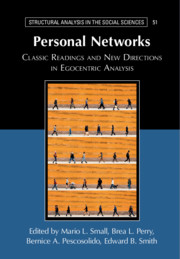Book contents
- Personal Networks
- Structural Analysis in the Social Sciences
- Personal Networks
- Copyright page
- Contents
- Figures
- Tables
- Contributors
- I Background
- II Early Foundations
- III Later Foundations
- IV New Perspectives
- 20 On Cognition
- 21 On Mobilization
- 22 On Trust
- 23 On Dynamics
- 24 On Inequality
- 25 On Culture
- 26 On Migration
- 27 On Movements
- 28 On Social Media
- Index
- Recent Books in the Series
- References
28 - On Social Media
Studying Social Media from an Egocentric Perspective
from IV - New Perspectives
Published online by Cambridge University Press: 01 October 2021
- Personal Networks
- Structural Analysis in the Social Sciences
- Personal Networks
- Copyright page
- Contents
- Figures
- Tables
- Contributors
- I Background
- II Early Foundations
- III Later Foundations
- IV New Perspectives
- 20 On Cognition
- 21 On Mobilization
- 22 On Trust
- 23 On Dynamics
- 24 On Inequality
- 25 On Culture
- 26 On Migration
- 27 On Movements
- 28 On Social Media
- Index
- Recent Books in the Series
- References
Summary
An overview of empirical findings, emerging theories, and challenges to the ego-centric perspective in the study of social media and digital technologies broadly. The relationship between social media use and network size and diversity has been discussed in relation to topics that include social capital, social support, political engagement, and mental health. We explore the role these technologies play in shaping networks, and how the ego-centric perspective can advance the study of social media. Two trends – persistent contact and pervasive awareness – are explored for their potential to counter transitory, segmented personal networks. The ego-centric perspective can play an important role in the study of social media, which has primarily focused on understanding how media works as an agent of change, while overlooking opportunities for research related to social influence and network flows. However, ego-centric researchers face methodological challenges, including the risk of overgeneralizing from social media platforms to personal networks more broadly, and the role of algorithmic personalization. We end with a discussion of how ever shifting social media platforms remain a barrier to advancing one of the most promising opportunities for the ego-centric approach: combining relational data from social media platforms with data from other sources, such as surveys.
Keywords
- Type
- Chapter
- Information
- Personal NetworksClassic Readings and New Directions in Egocentric Analysis, pp. 718 - 733Publisher: Cambridge University PressPrint publication year: 2021
References
- 4
- Cited by

